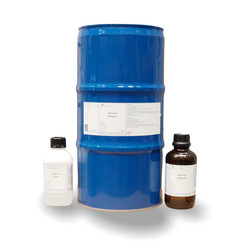You have no items in your shopping cart
Sulphuric acid
Sulfuric acid is a chemical compound of sulfur with the empirical formula H2SO4. It is a colorless, oily, very viscous and hygroscopic liquid. Sulfuric acid is one of the strongest acids and is very corrosive. This mineral acid forms two series of salts, the hydrogen sulfates and the sulfates, in which one or two protons are replaced by cations as compared to the free acid.
Sulfuric acid is one of the most technically important chemicals of all and is one of the most widely produced basic chemical substances. About 135 million tons of sulfuric acid was produced in 1993. It is mainly used in fertilizer production and for the production of other mineral acids, such as hydrochloric or phosphoric acid. Usually, aqueous solutions of different concentrations are used.
The anhydride of sulfuric acid is sulfur trioxide (SO3). The solution of sulfur trioxide in the sulfuric acid outside of the stoichiometric ratio is called fuming sulfuric acid or oleum, as the sulfur trioxide it contains easily escapes from solution and forms fog ("smoke") from dilute sulfuric acid with the moisture. Related acids are sulfurous acid (H2SO3), which is derived from sulfur dioxide, and thiosulfuric acid (H2S2O3), in which one oxygen atom has been replaced by sulfur.
Applications
Sulfuric acid is used in very large quantities and in many areas. In addition to that of chlorine, their production volume is a measure of industrial development and the performance level of a country.
It is named differently depending on the concentration. Between 10% and 20% it is called dilute sulfuric acid or dilute acid. Battery acid or battery acid has an acid concentration of 33.5%. These acids remain liquid even below 0 ° C.
Sulfuric acid with a content of up to about 70% is called room acid, up to 80% gloversic acid. Concentrated sulfuric acid has a minimum content of 98.3% (azeotrope). Dilute acid is found in large quantities as a waste product in the production of titanium oxide or colorant.
Most of it is used in fertilizer production. With the help of sulfuric acid, mainly phosphate and ammonium sulfate fertilizers are obtained. The latter is represented by the reaction of semi-concentrated sulfuric acid with ammonia.
In the production of phosphate fertilizers sulfuric acid is needed to break down the crude phosphate. The reaction produces superphosphate Ca (H2PO4) 2 / CaSO4
In addition to ammonium sulfate, other sulfates are also produced by reacting corresponding salts with sulfuric acid. An example is aluminum sulfate obtained from aluminum hydroxide, which is used in large quantities in the paper industry and as a flocculant in water purification.
Since many ores are soluble in sulfuric acid, it can be used as a digestive agent. Examples are the wet process for the production of zinc from zinc oxide and the sulfate process for obtaining the white pigment titanium dioxide. With the help of sulfuric acid, not only oxidic ores but also those with other anions such as fluoride or phosphate can be digested. The corresponding acids are formed during the reaction. This process is relevant for the production of some technically important acids. Examples are hydrofluoric acid from fluorite, phosphoric acid from apatite and hydrochloric acid from halite. As battery acid, sulfuric acid is an important part of the lead accumulator that is used as a starter battery in cars. As with the lead-acid battery, dilute sulfuric acid also serves as an electrolyte in electrolytic processes. The advantages over other electrolytes are their high conductivity and at the same time their low tendency to decrease.
In organic chemistry, the sulfonic acid group can be introduced by fuming sulfuric acid (sulfonation). It is mainly used to produce surfactants for the detergent industry and dyes. Another functional group that can be introduced with the help of sulfuric acid is the nitro group. This is done with the help of so-called nitriding acid, a mixture of sulfuric acid and nitric acid.
Sulfuric acid is one of the most commonly used chemicals in chemical laboratories. In addition to hydrochloric and nitric acids, it is a strong acid that is widely used. It is used, among other things, to adjust the pH value, as a catalyst for esterification, for example, and to smoke during digestion. The highly dehydrating effect of sulfuric acid is used to dry organic substances and gases in desiccators and washing bottles.

